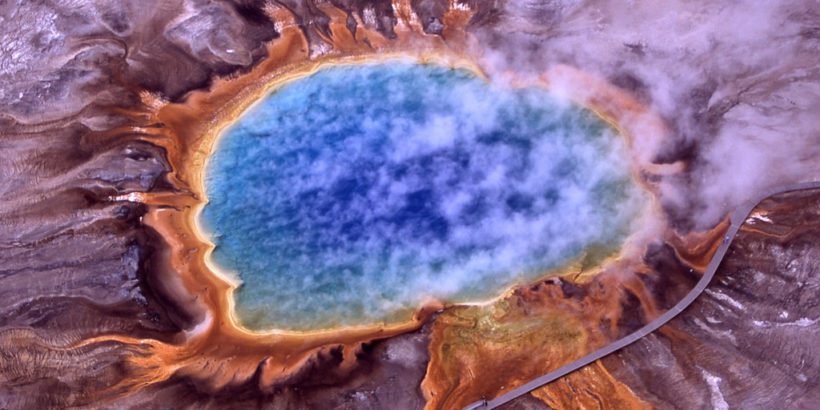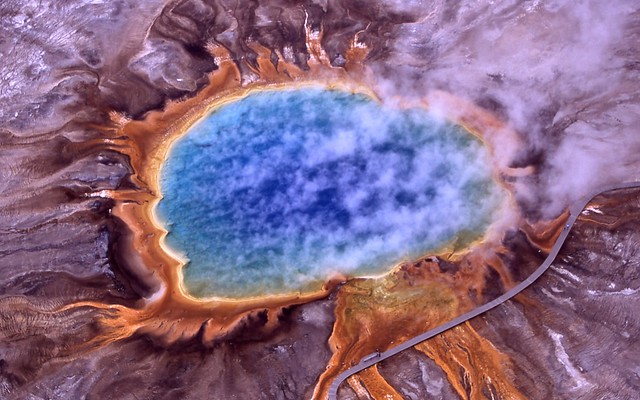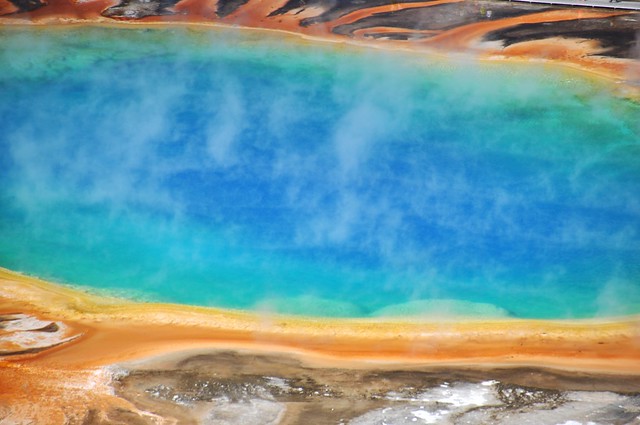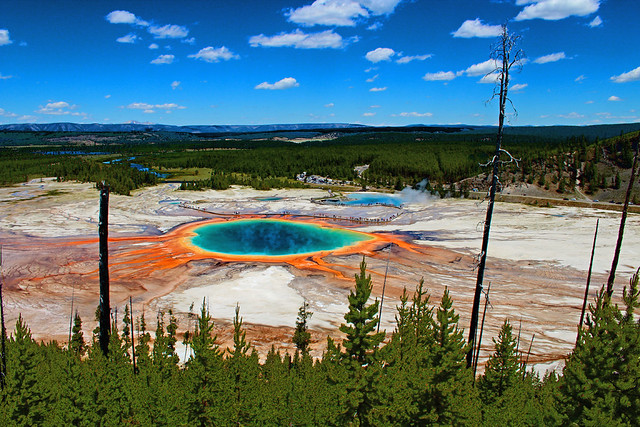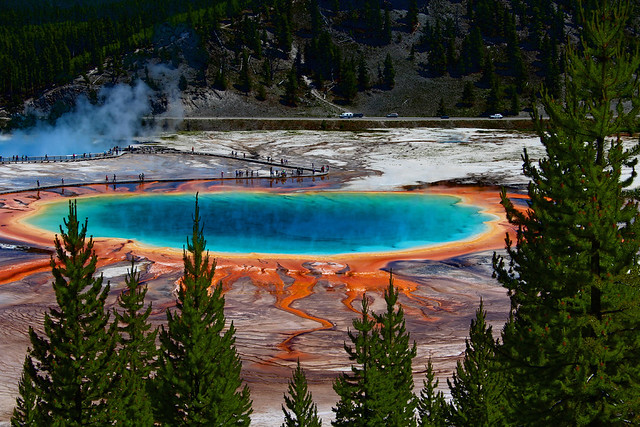The Grand Prismatic Spring — the famous brightly colored hot spring found in Yellowstone — may be one of the most iconic sites of all of the National Parks in the United States. Its vivid rings stretch 370 feet across forming the largest hot spring in all of Yellowstone Park and is considered to the third largest hot spring in the world (behind two hot springs in New Zealand).
Tip: Use WalletFlo for all your credit card needs. It’s free and will help you optimize your rewards and savings!
It was first officially described by the Hayden Expedition in 1871 when the leader of the expedition, Ferdinand Hayden, remarked
Nothing ever conceived by human art could equal the peculiar vividness and delicacy of color of these remarkable prismatic springs. Life becomes a privilege and a blessing after one has seen and thoroughly felt these incomparable types of nature’s cunning skill.
Human art did attempt to equal this “peculiar vivdness” soon after, however. Around 1870, an artist by the name of Thomas Moran made water-color sketches depicting its supremely vibrant colors and his painting caused many to doubt that such a wondrous thing could exist (it seems the #NoFilter debate’s been going on longer than we thought).
The skepticism around this painting caused many individuals, including geologist A.C. Peale, to visit the hot spring just to verify that these amazing colors were more than just a figment of someone’s imagination.
Hot springs in this region are generally formed as rain and snow melt pours from the mountain peaks into the porous rocks and drops into the rock chambers that are heated from underground magma chambers. Under the Earth’s surface, the water is under extreme pressure and weight and this keeps the water in its liquid state and also creates more buoyant water that slowly rises back to the surface.
Hot springs are formed from many of the same mechanisms present in geysers with the main difference being that the “plumbing” of a geyser always involves some form of blockage that causes the pressure to build up and results in the eruption of water every so often. In the case of the Grand Prismatic spring, water rises from 121 feet from underground chambers and pumps out at an estimated 560 gallons per minute to form the natural work of art admired by visitors every year.
The range of colors found inside the hot spring are the product of a different water temperatures that facilitate the growth of certain kinds of bacteria depending on their temperature.
The middle is actually the hottest part of the hot spring and reaches temperatures of up to 189°F. This is too hot for most life forms to flourish and thus the water in the middle is sterile and pretty much void of living organisms (though some very basic and limited life forms can exist in this zone).
Because no significant organisms live in the middle, the deep blue found in this section of the spring isn’t colored by algae; instead, it’s the product of blue wavelengths being scattered (the same process that makes the ocean appear blue to us). The sterile nature of the water and the deep chamber of the pool intensify this effect, producing the striking blue that makes up the middle of the hot spring.
As the water disperses from the middle of the hot spring it cools creating circles that differ in temperature and thus house different forms of life. One type of organism that flourishes is cyanobacteria. On the outside of the blue rim, where the water changes to a stark contrast of yellow and drops to more hospitable temperatures close to 165°F, one particular type of cyanobacteria survives known as Synechococcus.
However, this bacteria doesn’t have it easy trying to survive in these waters. First, these waters in the “yellow zone” are actually much hotter than Synechococcus prefers so it’s forced to deal with the stress of high temperatures. But the hot water isn’t the only challenge.
Due to the absence of trees and the high elevation where UV rays are stronger, these bacteria also must battle against the Sun for their survival. They endure this battle by reflecting certain wavelengths of light by relying on photosynthetic pigments, such as chlorophyll and carotenoids. The latter produces the red, orange, and yellow colors found in the hot spring and the former produces the blue-green colors typically associated algae.
The color production of carotenoids is really only a byproduct of its vital function that serves to protect the Synechococcus when exposed to harsh conditions. For example, when Synechococcus is exposed to high levels of UV waves, the carotenoids pass the energy from these wavelengths to chlorophyll, essentially redirecting the harmful rays that would have wreaked havoc on the bacteria cells.
The more harsh the living conditions the more carotenoids are produced and thus the more yellow the water appears. Interestingly, as fewer UV rays are cast into the spring during the winter months, the hot spring actually changes color to a more blueish-green color, closer to the natural color balance of Synechococcus.
The next ring layer is bright orange and is a bit cooler at around 150°F. Some Synechococcus still manages to live in this zone but another type, known as chloroflexi bacteria, also lives in this part of the hot spring. These bacteria create energy by using different types of chlorophyll and different types of carotenoids, which are responsible for the orange color ring.
Like the yellow ring, this bright color ring also serves the purpose of reflecting sunlight that would otherwise threaten the survival of the bacteria. While many of the bacteria in this ring of the spring may produce slightly different shades and tones individually, the cumulative effect produces the bright orange color.
Finally, on the outermost edge of the Grand Prismatic Spring is the dark red and brown color. This layer houses the most diverse range of bacteria and is lower in temperature, usually around 130°F.
Tip: Use WalletFlo for all your credit card needs. It’s free and will help you optimize your rewards and savings!
If you want to check out the Grand Prismatic Spring then head to the Midway Geyser Basin section of Yellowstone National Park. You can follow the crowds on the main boardwalk and get up close views of the Grand Prismatic Spring but perhaps the best view is taken from the Midway Bluff trail.
This trail isn’t marked on park maps but it can be found on the east side of the Grand Loop Road (south of the Midway geyser basin parking lot) where you can pull off the road and begin the hike.The advantage to doing this hike is the aerial view you’re given that isn’t obscured by the steam that would hinder your view on the ground level.
It’s a rather short hike (approximately 1/4 mile) but quite steep so if you’re not in shape it might test you a bit. Also, this is what’s called a “social trail” which is a trail that’s not officially maintained by a park for various reasons. While it’s generally encouraged to only stay on certain official trails, many parks are okay with visitors venturing on social trails that don’t present dangers to the environment or to hikers. However, you should always check with park rangers before you depart on a social trail because they can always be subject to change.
Cover image: Jim Trodel via Creative Commons
Daniel Gillaspia is the Founder of UponArriving.com and the credit card app, WalletFlo. He is a former attorney turned travel expert covering destinations along with TSA, airline, and hotel policies. Since 2014, his content has been featured in publications such as National Geographic, Smithsonian Magazine, and CNBC. Read my bio.

